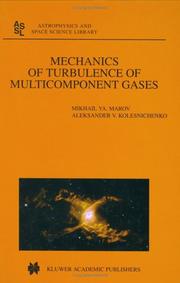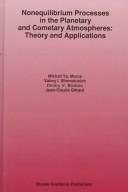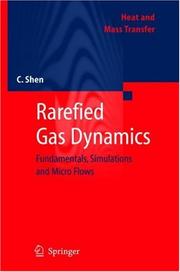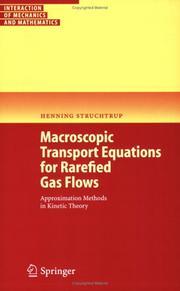| Listing 1 - 6 of 6 |
Sort by
|

ISBN: 0306480921 1402001037 Year: 2001 Publisher: Dordrecht : Springer Netherlands,
Abstract | Keywords | Export | Availability | Bookmark
 Loading...
Loading...Choose an application
- Reference Manager
- EndNote
- RefWorks (Direct export to RefWorks)
Space exploration and advanced astronomy have dramatically expanded our knowledge of outer space and made it possible to study the indepth mechanisms underlying various natural phenomena caused by complex interaction of physical-chemical and dynamical processes in the universe. Huge breakthroughs in astrophysics and the planetary s- ences have led to increasingly complicated models of such media as giant molecular clouds giving birth to stars, protoplanetary accretion disks associated with the solar system’s formation, planetary atmospheres and circumplanetary space. The creation of these models was promoted by the development of basic approaches in modern - chanics and physics paralleled by the great advancement in the computer sciences. As a result, numerous multidimensional non-stationary problems involving the analysis of evolutionary processes can be investigated using wide-range numerical experiments. Turbulence belongs to the most widespread and, at the same time, the most complicated natural phenomena, related to the origin and development of organized structures (- dies of different scale) at a definite flow regime of fluids in essentially non-linear - drodynamic systems. This is also one of the most complex and intriguing sections of the mechanics of fluids. The direct numerical modeling of turbulent flows encounters large mathematical difficulties, while the development of a general turbulence theory is hardly possible because of the complexity of interacting coherent structures. Three-dimensional non-steady motions arise in such a system under loss of la- nar flow stability defined by the critical value of the Reynolds number.
Planets --- Rarefied gas dynamics. --- Turbulence. --- Atmospheres. --- Flow, Turbulent --- Turbulent flow --- Fluid dynamics --- Superaerodynamics --- Fluid dynamics (Space environment) --- Gas dynamics --- Atmospheres of planets --- Planetary atmospheres

ISBN: 0792346866 Year: 1997 Volume: 217 Publisher: Dordrecht ; Boston ; London luwer academic publishers
Abstract | Keywords | Export | Availability | Bookmark
 Loading...
Loading...Choose an application
- Reference Manager
- EndNote
- RefWorks (Direct export to RefWorks)
Dynamica van verdunde gassen --- Dynamique des gaz raréfiés --- Gaz raréfiés--Dynamique --- Irreversible processes --- Onomkeerbare procédés --- Procédés irreversibles --- Rarefied gas dynamics --- Superaerodynamics --- Verdunde gassen--Dynamica --- Comets --- Irreversible processes. --- Planets --- Rarefied gas dynamics. --- Computer simulation. --- Atmospheres --- Planets - Atmospheres - Mathematical models. --- Computer simulation

ISBN: 9783540272304 9783540239260 Year: 2005 Publisher: Berlin ; New York, NY : Springer,
Abstract | Keywords | Export | Availability | Bookmark
 Loading...
Loading...Choose an application
- Reference Manager
- EndNote
- RefWorks (Direct export to RefWorks)
This book elucidates the methods of molecular gas dynamics or rarefied gas dynamics which treat the problems of gas flows when the discrete molecular effects of the gas prevail under the circumstances of low density, the emphases being stressed on the basis of the methods, the direct simulation Monte Carlo method applied to the simulation of non-equilibrium effects and the frontier subjects related to low speed microscale rarefied gas flows. It provides a solid basis for the study of molecular gas dynamics for senior students and graduates in the aerospace and mechanical engineering departments of universities and colleges. It gives a general acquaintance of modern developments of rarefied gas dynamics in various regimes and leads to the frontier topics of non-equilibrium rarefied gas dynamics and low speed microscale gas dynamics. It will be also of benefit to the scientific and technical researchers engaged in aerospace high altitude aerodynamic force and heating design and in the research on gas flow in MEMS.
Applied physical engineering --- Thermodynamics --- nanotechniek --- Fluid mechanics --- mechanica --- Engineering sciences. Technology --- ingenieurswetenschappen --- Electrical engineering --- BIT (biochemische ingenieurstechnieken) --- vloeistoffen --- thermodynamica --- Classical mechanics. Field theory --- Engineering. --- Chemical engineering. --- Nanotechnology. --- Rarefied gas dynamics. --- Gas dynamics. --- Molecular technology --- Nanoscale technology --- High technology --- Chemistry, Industrial --- Engineering, Chemical --- Industrial chemistry --- Engineering --- Chemistry, Technical --- Metallurgy --- Construction --- Industrial arts --- Technology --- Gasdynamics --- Fluid dynamics --- Superaerodynamics --- Fluid dynamics (Space environment) --- Gas dynamics

ISBN: 1280626011 9786610626014 376437537X 3764375345 Year: 2006 Publisher: Basel ; Boston : Birkhauser,
Abstract | Keywords | Export | Availability | Bookmark
 Loading...
Loading...Choose an application
- Reference Manager
- EndNote
- RefWorks (Direct export to RefWorks)
The book presents the mathematical tools used to deal with problems related to slow rarefied flows, with particular attention to basic concepts and problems which arise in the study of micro- and nanomachines. The mathematical theory of slow flows is presented in a practically complete fashion and provides a rigorous justification for the use of the linearized Boltzmann equation, which avoids costly simulations based on Monte Carlo methods. The book surveys the theorems on validity and existence, with particular concern for flows close to equilibria, and discusses recent applications of rarefied lubrication theory to micro-electro-mechanical systems (MEMS). It gives a general acquaintance of modern developments of rarefied gas dynamics in various regimes with particular attention to low speed microscale gas dynamics. Senior students and graduates in applied mathematics, aerospace engineering, and mechanical mathematical physics will be provided with a basis for the study of molecular gas dynamics. The book will also be useful for scientific and technical researchers engaged in the research on gas flow in MEMS.
Kinetic theory of gases. --- Rarefied gas dynamics. --- Statistical mechanics. --- Mechanics --- Mechanics, Analytic --- Quantum statistics --- Statistical physics --- Thermodynamics --- Superaerodynamics --- Fluid dynamics (Space environment) --- Gas dynamics --- Gases, Kinetic theory of --- Gases --- Molecular theory --- Statistical mechanics --- Mechanics. --- Differential equations, partial. --- Differentiable dynamical systems. --- Classical Mechanics. --- Partial Differential Equations. --- Dynamical Systems and Ergodic Theory. --- Differential dynamical systems --- Dynamical systems, Differentiable --- Dynamics, Differentiable --- Differential equations --- Global analysis (Mathematics) --- Topological dynamics --- Partial differential equations --- Classical mechanics --- Newtonian mechanics --- Physics --- Dynamics --- Quantum theory --- Partial differential equations. --- Dynamics. --- Ergodic theory. --- Ergodic transformations --- Continuous groups --- Mathematical physics --- Measure theory --- Transformations (Mathematics) --- Dynamical systems --- Kinetics --- Mathematics --- Force and energy --- Statics

ISBN: 9783540245421 3540245421 3540323864 Year: 2005 Publisher: Berlin, Heidelberg : Springer Berlin Heidelberg : Imprint: Springer,
Abstract | Keywords | Export | Availability | Bookmark
 Loading...
Loading...Choose an application
- Reference Manager
- EndNote
- RefWorks (Direct export to RefWorks)
The well known transport laws of Navier-Stokes and Fourier fail for the simulation of processes on lengthscales in the order of the mean free path of a particle that is when the Knudsen number is not small enough. Thus, the proper simulation of flows in rarefied gases requires a more detailed description. This book discusses classical and modern methods to derive macroscopic transport equations for rarefied gases from the Boltzmann equation, for small and moderate Knudsen numbers, i.e. at and above the Navier-Stokes-Fourier level. The main methods discussed are the classical Chapman-Enskog and Grad approaches, as well as the new order of magnitude method, which avoids the short-comings of the classical methods, but retains their benefits. The relations between the various methods are carefully examined, and the resulting equations are compared and tested for a variety of standard problems. The book develops the topic starting from the basic description of an ideal gas, over the derivation of the Boltzmann equation, towards the various methods for deriving macroscopic transport equations, and the test problems which include stability of the equations, shock waves, and Couette flow.
Rarefied gas dynamics. --- Gaz raréfiés, Dynamique des --- Engineering. --- Mathematics. --- Statistical physics. --- Thermodynamics. --- Engineering Thermodynamics, Transport Phenomena. --- Applications of Mathematics. --- Statistical Physics. --- Physics and Applied Physics in Engineering. --- Rarefied gas dynamics --- Applied Physics --- Engineering & Applied Sciences --- Superaerodynamics --- Applied mathematics. --- Engineering mathematics. --- System theory. --- Heat engineering. --- Heat transfer. --- Mass transfer. --- Engineering Thermodynamics, Heat and Mass Transfer. --- Complex Systems. --- Engineering, general. --- Statistical Physics and Dynamical Systems. --- Fluid dynamics (Space environment) --- Gas dynamics --- Physics --- Mathematical statistics --- Chemistry, Physical and theoretical --- Dynamics --- Mechanics --- Heat --- Heat-engines --- Quantum theory --- Math --- Science --- Construction --- Industrial arts --- Technology --- Statistical methods --- Dynamical systems. --- Dynamical systems --- Kinetics --- Mathematics --- Mechanics, Analytic --- Force and energy --- Statics --- Engineering --- Engineering analysis --- Mathematical analysis --- Mass transport (Physics) --- Thermodynamics --- Transport theory --- Heat transfer --- Thermal transfer --- Transmission of heat --- Energy transfer --- Mechanical engineering --- Dynamics. --- Transmission.
Book
ISBN: 1281045055 9786611045050 1402058659 1402058640 9048174627 Year: 2007 Publisher: Dordrecht : Springer Netherlands : Imprint: Springer,
Abstract | Keywords | Export | Availability | Bookmark
 Loading...
Loading...Choose an application
- Reference Manager
- EndNote
- RefWorks (Direct export to RefWorks)
The transport of a given species (atoms, molecules, neutrons, photons, etc. ), either through its own kind or through some other host medium, is a problem of considerable interest. Practical applications may be found in many technologically and environmentally relevant areas such as the transport of neutrons in a nuclear power reactor or in a nuclear weapon, the transport of ions and electrons in plasma, the transport of photons which constitutes radiative heat transfer in various industrial, environmental and space applications, the transport of atoms or molecules of one species either through itself or as one component of a multi-component gas mixture, and the interactions of such gas mixtures with various solid and liquid surfaces such as one might find associated with capillary tubes, aerosol particles, interstellar dust grains, etc. . These application areas are obviously quite broad and it is readily apparent that there are, indeed, few scientific activities that do not require some level of understanding of transport processes. One of the most important and influential texts in the area of transport theory has been The Mathematical Theory of Non-Uniform Gases by Sidney Chapman and T. G. Cowling that was first printed in 1939. This book, along with several other more recent texts (Hirschfelder, J. O. , Curtiss, C. F. and Bird, R. B. , Molecular Theory of Gases and Liquids, John Wiley and Sons, NY, 1954; Kogan, M. N.
Boundary value problems. --- Gases --- Kinetic theory of gases --- Rarefied gas dynamics. --- Transport properties. --- Mathematics. --- Superaerodynamics --- Fluid dynamics (Space environment) --- Gas dynamics --- Gases, Kinetic theory of --- Molecular theory --- Statistical mechanics --- Fluids --- Matter --- Gas laws (Physical chemistry) --- Pneumatics --- Boundary conditions (Differential equations) --- Differential equations --- Functions of complex variables --- Mathematical physics --- Initial value problems --- Properties --- Thermodynamics. --- Engineering. --- Chemical engineering. --- Surface and Interface Science, Thin Films. --- Classical and Continuum Physics. --- Engineering Thermodynamics, Heat and Mass Transfer. --- Fluid- and Aerodynamics. --- Industrial Chemistry/Chemical Engineering. --- Chemistry, Industrial --- Engineering, Chemical --- Industrial chemistry --- Engineering --- Chemistry, Technical --- Metallurgy --- Construction --- Industrial arts --- Technology --- Chemistry, Physical and theoretical --- Dynamics --- Mechanics --- Physics --- Heat --- Heat-engines --- Quantum theory --- Surfaces (Physics). --- Interfaces (Physical sciences). --- Thin films. --- Continuum physics. --- Heat engineering. --- Heat transfer. --- Mass transfer. --- Fluids. --- Hydraulics --- Hydrostatics --- Permeability --- Mass transport (Physics) --- Thermodynamics --- Transport theory --- Heat transfer --- Thermal transfer --- Transmission of heat --- Energy transfer --- Mechanical engineering --- Classical field theory --- Continuum physics --- Continuum mechanics --- Films, Thin --- Solid film --- Solid state electronics --- Solids --- Surfaces (Technology) --- Coatings --- Thick films --- Surface chemistry --- Surfaces (Physics) --- Interfaces (Physical sciences) --- Field theory (Physics) --- Transmission.
| Listing 1 - 6 of 6 |
Sort by
|

 Search
Search Feedback
Feedback About UniCat
About UniCat  Help
Help News
News